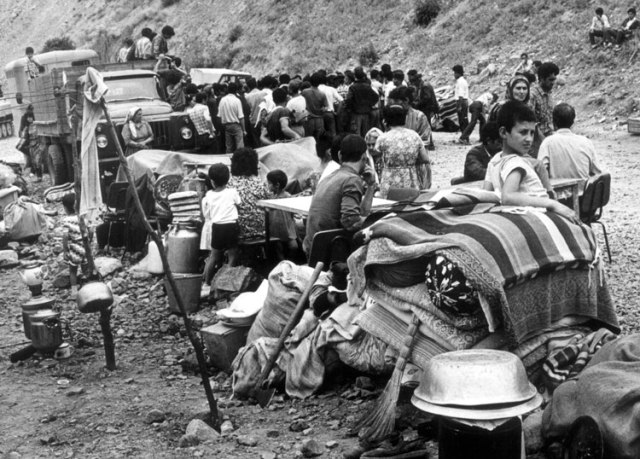
The Armenia's claims on Azerbaijani lands, as well as the Upper Karabakh formed pars of its strategy of the establishment of the Great Armenia. Therefore, Armenia always tried to make use of favorable conditions to achieve their goals. When pro-Armenian M.S.Gorbachyov was elected the head of USSR in 1985, Armenians intensified their activity again.
The support and protection of the Soviet government to armed Armenian separatists was coming to light during that period. In order to implement his mean plans connected with the autonomous province of Nagorno Karabakh, Mikhail Gorbachev distanced the most important obstacle — Heydar Aliyev — from the political bureau. After that Armenian academician A.Aganbekyan of Gorbachov's grouping, reported that he had made a proposal to the Soviet leadership concerning the Upper Karabakh and expressed hope that the problem will find its solution in the conditions of democracy and reconstruction. Once underground Armenian Committee for Karabakh and its terrorist organization Krunk (Crane) in the Autonomous District of Upper Karabakh started operating openly and the movement Miatsum movement was formed at that time. This movement was backed by Armenia, Autonomous District of Upper Karabakh, Moscow leadership and the potential of USSR and world Armenians. The events acquired more aggressive form in 1988. The wave of meetings of separatists and Armenian nationalists captured Yerevan and Stepanakert in February. The session of the council of Autonomous Upper Karabakh District appealed to the Supreme Council of Azerbaijan SSR for consideration of the status of the district February 20.
This fact testified that Armenians had changed their tactics from that of November 1945. They managed to create an incorrect view of the world community on Upper Karabakh through intensive propaganda and strong Armenian Diaspora in foreign countries. Therefore, they started to hold propaganda openly. The leadership of Azerbaijan and its community was unprepared for the new tactics of Armenian separatists and their supporters. The murder of two young Azerbaijanis, wounding of 19 people by Armenian separatists in Askeran February 20, resulted in the preparation of policy against the plans of Armenians. In late February the special service bodies and organs of State Security of SSSR committed a tragedy in the big industrial city of Azerbaijan-Sumgayit. The causes of Sumgayit tragedy soon came to light. That step targeted Azerbaijanis living in Armenian and was used to part Upper Karabakh from the Soviet Azerbaijan. "4 residents of Mehmandar village of Azerbaijan south to Yerevan were killed on March 10. Over 100 houses were destroyed and residents were evicted from the Azerbaijani villages of Ararat region on March 25. In mid March Armenians again attacked Azerbaijani villages near Yerevan….". The barbarism of Armenians against Azerbaijanis rose again.

In period of excavation of Armenian separatists' barbarism the indifference of the Communist party of Soviet Union to the real assessment of the state of the Central Committee and Soviet leadership also became evident. The resolution "On measures for intensification of socioeconomic development of the Autonomous Province of Upper Karabakh of the Azerbaijan SSR in 1988-1995" was a bid to cover up the separatist nature of the issue. This step inspirited Armenian separatists and even increased their aggression. The leadership of Azerbaijan, beginning with A.Vezirov, submissive to Moscow, stood on the position of compromises to betrayers and aggressors of its people. Finally, Moscow undertook one more step to part the Autonomous Province of Upper Karabakh from the Azerbaijan SSR: the Presidium of the USSR Supreme Council approved a resolution "On special form of government in the Autonomous Province of Upper Karabakh" on January 12, 1989. The aim was obvious: The Special Governing Committee, established in the Autonomous Upper Karabakh Province was to provide for the delivery of Upper Karabakh to Armenia. However, as a result of a democratic struggle of Azerbaijani people aware of that, the Special Governing Committee was abolished on November 28. Yet the structure was replaced by a new one-the Organizational Committee. Armenia, making use of it, carried out an anti-constitutional decision on annexation of Upper Karabakh to Armenia on December 1. That was the open violation of the territorial integrity of the Soviet Azerbaijan. As expected, Moscow shut its eyes to the fact of this violent intervention, thus deteriorating the situation. The leadership of USSR, led by Gorbachov, undertook one more cruel step against Azerbaijan. Baku was chosen the main target. The Soviet Union violating the constitutional responsibilities before the people, bringing large troops, armed with up-date techniques and guns, committed bloodshed in Baku on the night of January 20, 1990. Armenian soldiers and militants also took an active part in committing the Baku tragedy. However, the tragedy of January 20 could not undermine the control of Azerbaijan it even strengthened the struggle of the people for the independence and territorial integrity. The next day Heydar Aliyev came to the Azerbaijan's representation in Moscow, exposed the criminal actions of Soviet leadership and expressed his support for the justice Salvation struggle of Azerbaijani people. The Supreme Council of the Soviet Azerbaijan declared the restoration of the state independence on August 30, 1991 and approved the Constitutional act on the national independence on October 18. Armenian separatists of Upper Karabakh took advantage of the situation and continued creating political structures. They declared the establishment of a puppet body named The Upper Karabakh Republic in September of 1991. The Azerbaijan Republic did not accept this structure and the status of the Autonomous Province of Upper Karabakh was abolished on November 26.
The collapse of USSR in late 1991 was followed by the change in the geopolitical situation on post-Soviet area. Armenian in fact declared an open and unfair war against Azerbaijan. Armenian military troops, violating the borders of Azerbaijan, entered Karabakh and conjointly with Armenian separatists of Upper Karabakh occupied Azeri lands.
Institute of History named after A.Bakykhanov of ANAS



